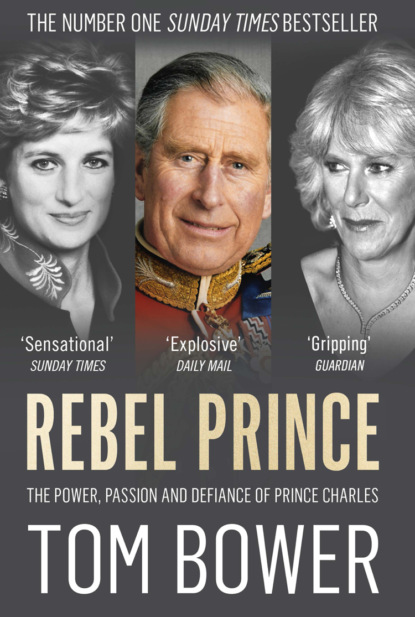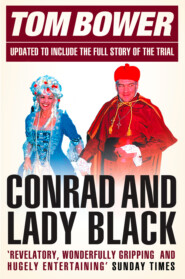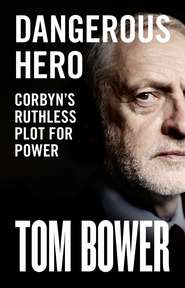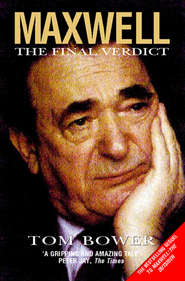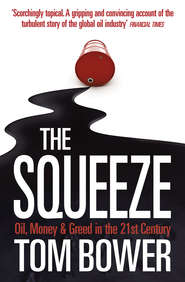По всем вопросам обращайтесь на: info@litportal.ru
(©) 2003-2024.
✖
Rebel Prince: The Power, Passion and Defiance of Prince Charles – the explosive biography, as seen in the Daily Mail
Настройки чтения
Размер шрифта
Высота строк
Поля
Encouraged by public acclaim, he next supported Stephen O’Brien, the founder of Business in the Community, a new charity for galvanising entrepreneurs to invest in deprived areas. ‘What really worries me is that we’re going to end up as a fourth-rate country,’ Charles wrote in 1984. Business leaders were invited to meet him in city slums and support their renewal. ‘I have no political agenda,’ he wrote, describing his ambition to put the ‘Great’ back into Great Britain. Presenting himself as a social crusader determined to help Britons to live in a civilised environment, Charles sought the financial support of powerbrokers wherever he could find them.
By 1996, besides the Prince’s Trust, Charles had created charities for education, the environment, architecture, complementary medicine, animals, the sick, the poor and rural communities. But he was careless about their governance. He gave the impression that the trustees of each charity – with its own niche focus, independent board, trustees and funds – acted free of his interference, since by law he was denied any role in their management. The reality was different. The Charity Commission complained that Charles was playing an unauthorised role in the running of the charities. The solution was to appoint new chairmen.
Finance presented a more pressing problem. Charles was an excellent fundraiser, and all the charities relied on him, competing for his appearances at receptions and dinners. Each charity chairman would assure each corporate chief executive that Charles would be present at a reception and would meet the charity’s beneficiaries. Charles encouraged such promises without considering the impossibility of fulfilling all of them, or the folly of repeatedly targeting the same donors. ‘He can pursue different projects simultaneously,’ observed one adviser, ‘but in parallel rather than together.’
Even after a donation and an event had been agreed, those making the plans would encounter ‘the nightmare of Charles’s bureaucracy’, complained the long-serving director of one of the charities. His officials, either former civil servants or military officers, invoked his authority to block arrangements. ‘They were always negative that he should not do things,’ complained one charity executive, ‘but they hadn’t seen the real world, and got it wrong.’
In a pattern that repeated itself over the next twenty-five years, Charles’s good intentions were often derailed. Because he spread himself so thinly, some of his charities failed to raise sufficient funds, while the Prince’s Trust, which employed three hundred staff in a splendid Nash house opposite Regent’s Park, spent an excessive amount on administration.
Unspoken at his charities’ meetings was the fact that Charles’s work had been tarnished by duplication. For example, in 1987 he had launched Inner City Aid, a self-help project founded in partnership with the architect Rod Hackney. On the same day he had also founded the Prince’s Youth and Business Trust. Both charities targeted the same disadvantaged groups.
During those meetings, Charles would frequently say, ‘I have always thought it would be a jolly good idea if we could do something to help …’ Speaking in third-person messages rather than giving a clear directive, he watched as his audience – Shebbeare, his successive private secretaries, and Julia Cleverdon, an imaginative, energetic but occasionally chaotic campaigner renowned as a ‘whirlwind of activity’, recorded his wishes on A4 notepads. Sycophancy prevented anyone from challenging Charles to ask, ‘I wonder, sir, if that’s a good idea?’ They knew how sensitive the prince was to confrontation. The rare contradiction would be followed by a communal sharp intake of breath, then stony silence. Palace etiquette forbade any hint of rebuke. Cleverdon would wave aside questions about shaky finances with cryptic advice such as that to Peter Davis, her deputy: ‘Beware of tidy graveyards.’
Like Cleverdon, Shebbeare was both enthusiastic and deferential, but when faced with the necessity of giving unwelcome advice, he too preferred to stay silent. The most either would say was, ‘Yes, sir, but …’ before tailing off. Power did not want to hear the truth. ‘It was difficult to say “No,”’ Shebbeare admitted to a friend, ‘because the automatic punishment was that he would find someone else to say “Yes.”’
Persuading Charles to reverse a poor decision was best done by putting on an elaborate act. First, one had to be the last person to talk to him on a chosen subject, by remaining in the room after others had left. Then, graciously thanking His Royal Highness for the opportunity of a private moment, the adviser would preface his presentation with an offer to interpret His Royal Highness’s wishes with a wholly unthreatening offer of help: ‘Sir, might we just do the same by just a slightly different route?’ Such manoeuvres protected Charles from many mistakes.
One of the casualties of this system was Jeremy White, a successful British businessman based in Los Angeles who had been recruited in 1993 to manage the Prince’s Youth and Business Trust. Among the reasons he accepted the job was Charles’s successful negotiation with David Young, one of Margaret Thatcher’s favourite ministers, that the government would match all the money raised by Charles. With ample funds, the trust helped forty thousand young people to start micro-businesses. But this achievement, White discovered, was not admired by Shebbeare or Cleverdon. To impress the prince, both appeared to White to enjoy stamping on his fingers rather than cooperating to protect his success. The climax of the warfare arose in 1997, after the auction of a Lotus car, donated by the manufacturer, to help raise money for the trust. Lotus formally complained to Charles that White had failed to attend the event. ‘I would have been there if Shebbeare had told me about it,’ commented White, who immediately resigned and went on to earn his own fortune as a businessman. ‘He was from the commercial world,’ sniffed Shebbeare to an aide, ‘and didn’t get on with people.’
White’s departure did not trouble Charles. He believed that his saviour was to be Tony Blair, the new prime minister, who decided that Labour’s broad programme to help the disadvantaged was in synch with Charles’s ambitions. This meant that Shebbeare could attract more funds from the government.
For Charles to carve out a unique position in British public life would require more than just leading a large grouping of charities. He felt impelled to be noticed, admired, and considered relevant. His targets were vested interests: architecture, education and medicine. Over the years he had crafted a singular philosophy about the world, and his place at its apex, to justify his rebellion against modern society. His charities would provide a platform and justification for his campaigns.
He started with medicine. Few professions were more entrenched. The first hint of his coming campaign had been his 1982 address to the annual conference of the British Medical Association. To celebrate his election as the BMA’s new president, he used the invitation to criticise the profession’s rejection of alternative or complementary therapies.
Ever since he had been introduced to homeopathy by his grandmother and by Laurens van der Post, Charles had preached the virtues of unconventional treatments. Taking mixtures of plants, herbs and minerals, he believed, stimulated the body’s self-healing mechanism to treat serious illnesses. He also advocated acupuncture, chiropractic therapy and spine manipulation. Releasing the body’s vital forces, blocked by misaligned vertebrae, he was certain, was a verified therapy. Consistent with his belief in the power of God acting through the Divine Spirit, he was convinced that a sick person’s ‘inner awareness’ could enable them to ‘will’ their recovery ‘in relation to the cosmos’. A patient confident about ‘holism’ should welcome the simultaneous treatment of their illness and their spirit. Charles dismissed any doubts by referring to van der Post’s enthusiasm for the Swiss psychoanalyst Carl Jung, whose work on the ‘collective unconscious’, which unites mankind through a common vital force, advocated the power of such forms of healing.
Charles urged his audience at the conference to embrace alternative medicine, as ‘practised by folk healers who are guided by traditional wisdom’. For a thirty-four-year-old with a mediocre degree in history to preach the power of spiritualism, based on a jumble of ideas inherited from van der Post, Jung and the sixteenth-century Swiss healer and alchemist Paracelsus, and then to denounce, to an audience of doctors, the science that produced the drugs that had eradicated polio and tuberculosis, was as frightening as it was brazen – especially to a profession that was still struggling to cure heart disease, cancer and other fatal conditions.
His audience’s polite applause was welcome after the derision being heaped upon him every week for his eccentric beliefs in ITV’s satirical Spitting Image, and he would later admit that he had expected to be misunderstood and criticised by his audience. But the doctors were tolerant. They listened patiently as he lamented that it was his fate to ‘accept it is God’s will that the unorthodox individual is doomed to years of frustration, ridicule and failure in order to act out his role in the scheme of things, until his day arrives and mankind is ready to receive his message’.
Convinced of the ancestral wisdom of tribal societies, Charles idolised the pre-modern world. For him, the rationality of science was abhorrent. Believing in the hereditary principle, he invoked God’s power to appoint him as the spokesman for people’s unspoken concerns. ‘I have come to realise,’ he said, ‘that my entire life so far has been motivated by a desire to heal – to heal the dismembered landscape and the poisoned soil; the cruelly shattered townscape where harmony has been replaced by cacophony; to heal the divisions between intuitive and rational thought, between mind, body and soul so that the temples of our humanity can once again be lit by a sacred flame.’
Such thoughts were unusual for an heir to the throne. Some would criticise Charles for his pretensions of intellect, others for being a fantasist. To illustrate his so-called ‘crankiness’, they repeated gossip about Charles’s interest in a book about aliens recommended by Charlie Palmer-Tomkinson.
In hindsight, the doctors’ response to Charles’s speech was generous. Recognising his insecurity and pride, they paid lip service to his spiritual values. In a deferential gesture, Sir James Watt, the president of the Royal Society of Medicine, organised a series of eight seminars and a working party within the BMA to examine complementary medicine. Charles himself attended three meetings at the Royal Society, but was impatient with anyone advocating exclusive reliance on conventional medicine. ‘Science,’ he had told the doctors, ‘has tried to assume a monopoly – or rather a tyranny – over our understanding of the world around us … We are only now beginning to understand the disastrous results.’ His hostility towards drugs reflected his anger about doctors’ separation of the soul from the body. A healthy body, he told his audience, depended on treating soul and mind as one. His listeners were bewildered by his belief in the ability of the ‘soul’ to cure cancer. ‘Alternative medicine,’ one doctor would retort, ‘should remain the luxury of the well-to-do hypochondriac.’ The BMA issued a report concluding that complementary medicine was worthless, but it still approved further discussion.
Undeterred by his limited progress, Charles continued to argue that natural foods, proper education, sport and a healthier lifestyle, rather than drugs and hospital treatment, were the cures for illness. He visited the Bristol Centre, an ‘alternative’ drug-free cancer clinic established in 1981, and regularly championed environmental policies. He converted the Duchy of Cornwall’s farms to produce only organic food. Seemingly unaware of his apparent fickleness, he repeated the attacks against the doubters that he had first voiced in his BMA speech in 1982: ‘I have often thought that one of the least attractive traits of various professional bodies and institutions is the deeply ingrained suspicion and outright hostility which they can exhibit towards anything unorthodox or unconventional.’
With the tenacity of a proselytiser, in 1987 Charles began a campaign to make complementary medicine mainstream. The Maurice Laing Foundation was persuaded to donate £1.5 million for the first British university department devoted to the subject at Exeter University. Supported by Charles’s regular visits, in 1993 the university appointed Edzard Ernst, a forty-five-year-old medical doctor, to become the country’s first professor of complementary medicine. Ernst appeared an ideal choice. As the director of rehabilitation medicine at the Vienna Medical School, he had led a department of 120 in a two-thousand-bed hospital, and like many German doctors had routinely prescribed complementary medicines. During his ten-year contract at Exeter, he was tasked to ‘develop research into the techniques and effectiveness of the various branches of complementary medicine and to encourage the assimilation of appropriate complementary medicine techniques into orthodox medicine’. He anticipated bringing his skills as a scientist, university professor and clinical practitioner to subject complementary medicine to its first-ever evaluation based on impartial scientific trials. To test its credibility, additional staff would be funded by grants from government and private institutions.
Charles was optimistic that Ernst’s work would encourage British doctors to integrate complementary medicine into the NHS’s conventional treatments. But he failed to anticipate the German doctor’s refusal to judge all complementary medicines uniformly. Among more than four hundred alternative therapies and food supplements, Ernst sharply distinguished between herbs, acupuncture, osteopathy, aromatherapy, oils, diets and homeopathy.
Charles’s particular interest was homeopathy. True believers prescribed highly diluted doses of natural substances to treat bee stings, snakebites and mushroom poisoning, as well as more serious illnesses. By producing the same symptoms, they argued, the body would automatically stimulate its natural defences. Until 1993, tests of homeopathy had produced results ranging between encouraging, inconclusive, and having no effect whatever. In extreme cases, patients who relied exclusively on complementary medicine had died. Charles dismissed such findings as unreliable, and expected Ernst to confirm his own beliefs.
To supplement Ernst’s efforts, in 1993 Charles asked his friend Hugh van Cutsem and Ian Marks, a Cadbury’s philanthropist, to recruit Simon Mills, a herbal practitioner, to establish what became the Foundation for Integrated Health, which he expected to prove that mainstream medicine and complementary therapies could work together. The finance would be provided by Bach Barcapel, a charity funded by a manufacturer of complementary medicines. Mills accepted the position, but progress was slow, and four years later a dissatisfied Charles commissioned a working party to examine the obstacles. Called ‘Integrated Healthcare’, the subsequent report suggested ways to provide the public with information about and access to both types of medical care, and how to increase research, training and regulation of unorthodox treatments. To implement the recommendations, Marks appointed Michael Fox, the chief executive of an NHS trust, as the first director of a new foundation that would be financed by Charles. The appointment was strange, given that Fox was not convinced of the benefits of complementary medicine.
Fox met Charles six times a year to describe his progress. By 1998 he had barely started to overcome the medical profession’s resistance to the introduction of complementary medicine into the NHS. The prince, once again, was not pleased – as Mark Bolland explained to Fox, he was ‘not used to opposition’. Then, in 1998, Charles was confronted by an unexpected challenge.
After five years of research, Edzard Ernst changed his opinion. Applying scientific methods, he and his team of academics had become disillusioned. Too many arguments in defence of alternative medicine represented a flight from reason into the absurd. Manufacturers of homeopathic remedies were attempting to persuade patients that worthless but expensive coloured water was beneficial. Ernst rejected such chicanery. Placebos which generated a ‘false positive result’ with no medical effect, he decided, were not harmless. Sick people were dying as a result of relying on pseudo-science (including acupuncture and chiropractic) rather than receiving conventional treatment.
The country’s only professor of complementary medicine was not only arguing against his own specialty, but was critical of Charles for being ‘unwilling to distinguish between real health care and blatant quackery’. Ernst even criticised Exeter University’s BSc degree in complementary medicine as ‘a course in claptrap taught by uncritical believers to brainwash youngsters with mystical nonsense’. In his opinion, the supporters of complementary medicine, especially the fourteen thousand people registered with the Federation of Spiritual Healers, were unqualified preachers who resisted independent scientific research, especially that by medically trained academics.
To bridge the chasm between Charles and the medical profession, James Watt persuaded Lord Winston, a pioneer of in vitro fertilisation, that the House of Lords Science and Technology Committee should take up the subject of complementary medicine. Simon Mills, the peers agreed after a series of meetings, would write the committee’s report. To Mills’s relief, by the end of their hearings the peers recognised complementary medicine’s popularity, acknowledged some benefits, and accepted that some practitioners were reputable. However, pummelled by the searing scientific criticism directed at the new sciences by the biologist Lewis Wolpert – ‘That guy took the air out of our lungs!’ admitted Mills – the peers were sceptical about the value of most unorthodox therapies. The public, as Mills was forced to admit in his final report, was unprotected against the majority of untrained, unregulated and ‘incompetent’ practitioners, and many remedies lacked high-quality research. The peers’ conclusions were accepted by the government, ignored by the media and, as Mills decided, dismissed by complementary medicine practitioners as ‘rather too balanced for some tastes’. Charles conceded that after sixteen years he had made only pitiful progress against the most vested of interests – the medical profession. His foundation, he admitted in despair, had also failed. ‘It’s become a talking shop for like-minded people,’ Mills confirmed, ‘and not getting off the ground.’
Charles did seize on one of the peers’ recommendations: cooperation between conventional doctors and complementary medicine practitioners within the NHS should be improved. Pressured by him, the Department of Health agreed to give £18.5 million to the Royal London Homeopathic Hospital, and urged more access for the sick to the new sciences as part of the ‘integrated medicine’ promoted by Charles’s foundation. Encouraged by that success, the prince supported the introduction of a postgraduate course in the subject at Exeter, to attract more GPs to the faith. The pioneers included Michael Dixon, a Devon GP who dispensed complementary medicine and was active in the NHS Alliance.
Not surprisingly, Exeter’s medical school had sided with Charles against Ernst. Dixon now negotiated with Professor John Tooke, the Dean of the Peninsula Medical School at Exeter, to launch ‘Pathway in Integrated Health’, a course to encourage doctors to use complementary medicine.
By 2002, Charles’s irritation at Edzard Ernst’s criticism hit a new peak. Every study by Ernst’s department had denounced homeopathy as worthless. Ernst also opposed Charles’s foundation’s initiative to recruit GPs. ‘The information the foundation puts out,’ he wrote, ‘is dangerous and misleading. It’s an attempt to brainwash GPs and patients.’ That criticism was a good reason not to consult Ernst about the medical school’s new degree. Dixon’s official reason was bland: ‘The course was for generalists and practitioners – doctors and nurses. Ernst was not a clinician but a researcher. He was angry not to be consulted because he was used to Vienna’s hierarchical system, but it’s different in Britain.’
The prince felt vindicated, and looked around for a new target. He settled on the ‘barbarians’ ruining Britain’s landscape and cities.
7
The Masterbuilder (#ulink_f5e9795a-6425-5693-abed-1be672e6655f)
Towards the end of 1999, Charles’s disenchantment with Tony Blair increased. Much of New Labour’s promise of a fresh beginning – Blair’s pledge to be ‘whiter than white, purer than pure’ – had quickly become tainted. The exposure of Downing Street’s sleazy relationship with Bernie Ecclestone, the owner of Formula One motor racing, Alastair Campbell’s devotion to deceptive ‘spin’, the dispiriting arguments about school standards, and the plans for a vacuous dome in Greenwich to celebrate the millennium, all aggravated his mistrust. Charles blamed government ministers for evasion, especially about the environment. In turn, they felt that his expectations were often unrealistic. But honest debate was difficult with a dynast unwilling to listen to other points of view.
A fierce exchange with John Drummond, the arts administrator and BBC music controller, after a concert at the Bath Festival was an exception. The Bartók and Schoenberg he had just heard, Charles complained, was ‘like scraping a nail over a blackboard’.
‘Your taste in music,’ Drummond replied after a pause, ‘is as execrable as is your taste in art and architecture.’ Charles, he knew, enjoyed the more traditional music of Hubert Parry, composer of ‘Jerusalem’.
As their argument rolled on, the lord lieutenant of Somerset, who had accompanied Charles to the concert, became disturbed. ‘You must stop this,’ he urged Charles’s courtiers. ‘Interpose your body between them.’
‘I’m enjoying this,’ said Charles, laughing. ‘I like John. No one’s honest with me like that.’
Another who did not shrink from giving his opinion to power was Richard Rogers, the prominent British architect who in 2017 was to criticise the prince severely in his autobiography, A Place for All People. For years he had openly called Charles ignorant, privileged and feudal. His candour was not appreciated by its target, not least because in 1999 Rogers appeared to have registered a major victory over him. Not only had he designed the Lloyd’s insurance building, an edifice of glass, exterior metal pipes and lopsided steel, in the middle of the neoclassical City of London, but also the gigantic white fibreglass Millennium Dome, looming over the Thames at Greenwich.
For sixteen years, the two men had fought about the virtues and vices of modernist and traditional architecture. Rogers denounced Charles’s self-appointment as the people’s representative against modern architects as symbolic of anachronistic privilege. For his part, Charles was unyielding in his judgement of a man he regarded as a hypocritical champagne socialist. During the early years of Blair’s government, their battle was unequal. As an admirer of New Labour, Rogers had won the prime minister’s support for ‘Urban Vision’, his scheme to improve the quality of city life without regarding old buildings as untouchable. In 1998 John Prescott, the deputy prime minister, who was responsible for the environment, adopted Rogers’s scheme as government policy.
In 2000, soon after Ken Livingstone’s election as London’s mayor, Rogers was appointed his architectural adviser. Livingstone was paying Rogers £130,000 a year, even though the mayor’s office would also be considering the architect’s applications for planning permission in central London. Both shrugged aside any potential conflict of interest. Some of Rogers’s recommendations might have attracted Charles’s support, but architect and prince found any common ground distasteful. Charles wanted to protect London’s ancient skyline, especially the distant views of St Paul’s Cathedral; Rogers preached enthusiasm, endorsed by the mayor, for skyscraper office blocks.
Вы ознакомились с фрагментом книги.
Приобретайте полный текст книги у нашего партнера:
Приобретайте полный текст книги у нашего партнера:





